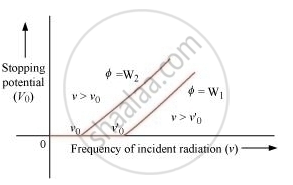Advertisements
Advertisements
प्रश्न
Plot a graph showing the variation of stopping potential with the frequency of incident radiation for two different photosensitive materials having work functions W1 and W2 (W1 > W2). On what factors does the (i) slope and (ii) intercept of the lines depend?
उत्तर

(i) The slope of the graph is content and equals to`(h/e)`. Therefore, the slope does not depend on any factor.
(ii) The intercept of the lines depends on the work function ‘’`phi` of the metals.
APPEARS IN
संबंधित प्रश्न
A negligibly small current is passed through a wire of length 15 m and uniform cross-section 6.0 × 10−7 m2, and its resistance is measured to be 5.0 Ω. What is the resistivity of the material at the temperature of the experiment?
What conclusion can you draw from the following observations on a resistor made of alloy manganin?
| Current A |
Voltage V |
Current A |
Voltage V |
| 0.2 | 3.94 | 3.0 | 59.2 |
| 0.4 | 7.87 | 4.0 | 78.8 |
| 0.6 | 11.8 | 5.0 | 98.6 |
| 0.8 | 15.7 | 6.0 | 118.5 |
| 1.0 | 19.7 | 7.0 | 138.2 |
| 2.0 | 39.4 | 8.0 | 158.0 |
Choose the correct alternative:
Alloys of metals usually have (greater/less) resistivity than that of their constituent metals.
A heating element is marked 210 V, 630 W. What is the value of the current drawn by the element when connected to a 210 V dc source?
A wire of length 1 m and radius 0.1 mm has a resistance of 100 Ω. Find the resistivity of the material.
The electrochemical equivalent of a material depends on _______________ .
How does the resistivity of a semiconductor change with rise of temperature ? Explain.
Choose the correct alternative:
The resistivity of a typical insulator (e.g., amber) is greater than that of a metal by a factor of the order of (1022/1023).
